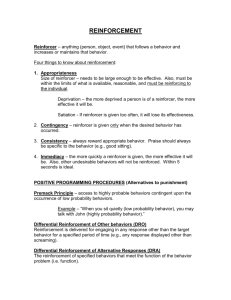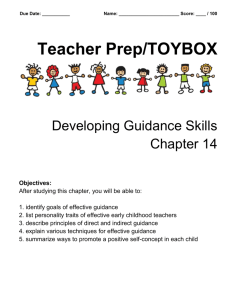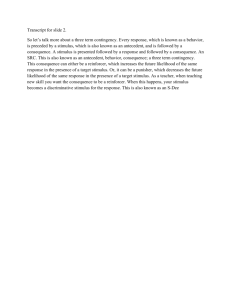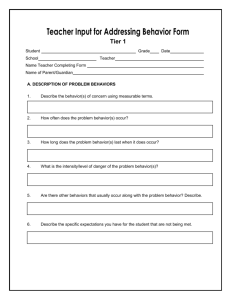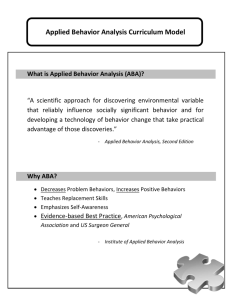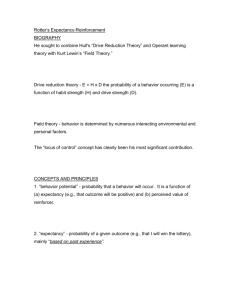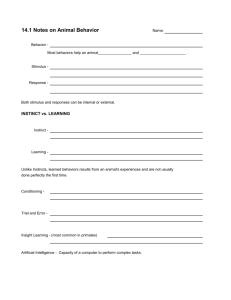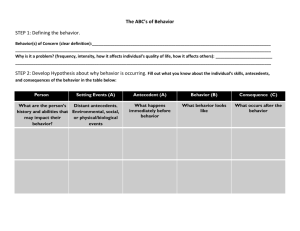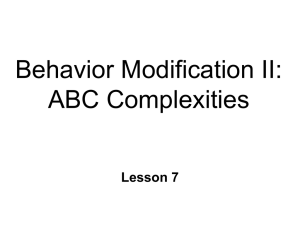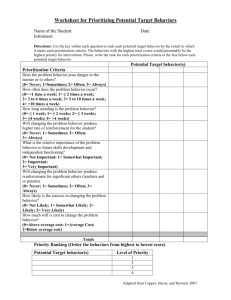Applied Behavior Analysis
advertisement
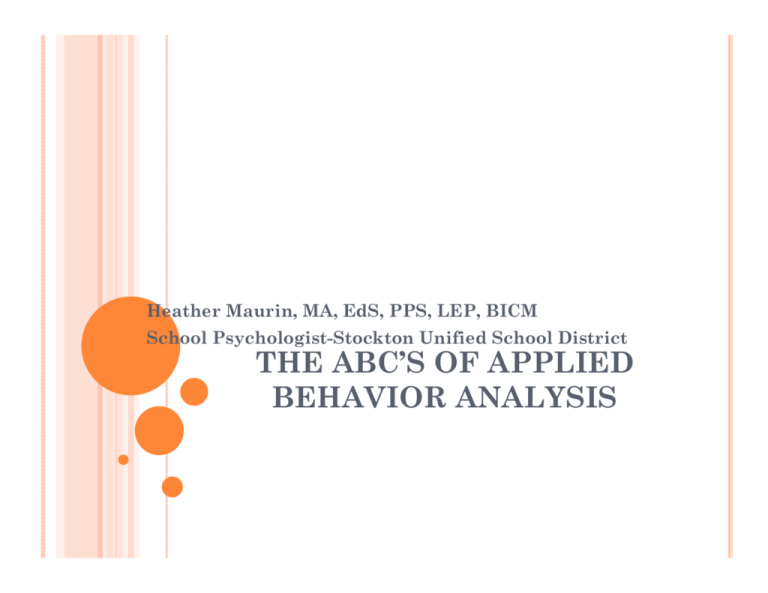
Heather Maurin, MA, EdS, PPS, LEP, BICM School Psychologist-Stockton Unified School District THE ABC’S OF APPLIED BEHAVIOR ANALYSIS WHAT IS BEHAVIOR Every behavior has a purpose. There is no behavior that is done that does not serve a function. | Behaviors are only contextually appropriate or inappropriate. | Behavior does not exist without being related to the environment. | y Behavior is an interaction of a person’s behavior with the environment in which it occurs. APPLIED BEHAVIOR ANALYSIS | What is ABA? The strategic and intentional application of scientific principles of human behavior and learning. y The purpose is to predict, influence and modify the occurrence of certain behaviors. | Teach or increase desired behaviors | Reduce or eliminate undesired behaviors y Used to analyze the environmental factors that influence behaviors, learning and motivation. y APPLIED BEHAVIOR ANALYSIS | Another way to think about ABA: If behavior is changing and learning is occurring, ABA is in happening! y If a child can learn maladaptive behavior, the same child can learn adaptive behavior! y Behavior is interactive. It is related to the environment and interacts with other’s behavior (it does not occur in a vacuum). y OPERANT CONDITIONING | This is the A-B-C model of behavior BF Skinner y Antecedent is the cue, signal or condition that influence the occurrence of the behavior…basically it is what happens right before the behavior occurs. y Behavior: An observable act that a person does. y Consequence: The outcome and/or feedback that occurs immediately following the behavior. y CLASSICAL CONDITIONING Ivan Pavlov | Unconditioned Stimulus (US)-Unconditioned Response (UR) | Conditioned Stimulus (CS) repeatedly paired with the Unconditioned Stimulus (US) results in a Conditioned Response (CR). | “Little Albert” and “Pavlov’s Dogs” | Can be used to teach. Pairing something pleasurable (CS) with something neutral (US), will result in a (CR). | ANTECEDENTS (ENVIRONMENTAL FACTORS) | In Teaching: Setting the stage for learning. y | Includes materials, setting, time of day, person or people present, how and what directions are given. In Problematic Behavior: Conditions or demands that “trigger” maladaptive behavior. y This can be instruction, materials, a sensory experience, a person or people, past experience, etc. y These must be looked at and interpreted to predict future behavior. y | Example: y Woman enters a room filled with smoke and screams “fire”. CONSEQUENCES | Results in an increase or decrease in the future likelihood of the behaviors. y | Reinforcing Consequences increase the likelihood of any behavior that produces positive outcomes. Positive Reinforcers: Providing something that increases the likelihood of the behavior occurring. y Positive Reinforcer Examples: Receiving a paycheck for working, being called on when you raise your hand, getting a soda out of a vending machine. CONSEQUENCES-CONTINUED | Negative Reinforcers: Removing an aversive stimulus which increases the likelihood of the behavior occurring again. y | Negative Reinforcer Examples: Taking an Ibuprofen to remove a headache, giving a tantruming child a candy bar to remove the sound of the scream. Punishing Consequences decrease the likelihood of any behavior that produces non-preferred outcomes. Examples of punishers: Response-Cost: Your response will cost you something. Extinction: When a behavior does not achieve the desired response. y Punishing does not mean that aversives are used. y ABC’S OF SKILL TEACHING | REINFORCEMENT IS KEY TO MOTIVATION!!!!!!! y Rewards (items or activities) that follow attempts at a target skill, that result in and increase in attempts or trying in the future. This creates an eager learner! | y When teaching a new skill this is particularly important to establish success. Bribes vs. Paycheck: You know what you are earning and therefore you are motivated to attain it! SCHEDULES OF REINFORCEMENT When teaching a new skill a 1:1 Fixed Ratio of Reinforcement is important to establish success (this is when each time a desired behavior occurs it is rewarded). | When maintaining a skill a lower ratio of reinforcement can be used (i.e. interval, variable). A variable schedule is very powerful when maintaining desired behavior. | FUNCTIONS OF BEHAVIOR | There are two main functions to behavior: y 1) To gain access to a “reinforcer” | y | With some children, the reinforcer they are gaining may be self-stimulatory. 2) To escape or avoid a “punisher” Functional means that the behavior is purposeful or useful for the student. INTERVENING WITH ANTECEDENTS AND CONSEQUENCES When ABA is typically used, we often focus on changing the consequence in order to change the behavior (i.e. providing a reinforcer if the desired behavior occurs) | Manipulating the consequence can be ineffective at times, specifically when the behavior is selfstimulatory (i.e. hand flapping). In these situations, altering the antecedent may be more helpful. | FUNCTIONAL COMMUNICATION | Form vs. Function Communication can take many forms: pointing, signing, visual pictures, vocalizing, hand leading. y Function is defined by why the person is doing it. y FUNCTIONAL COMMUNICATION | Speaker Skills: Requests | Asking for desired item/activities, asking for help, asking to get out of a situation. | These are influenced by an internal desire for something or an internal desire to escape/avoid something (Antecedent). | The consequence is that the desired item or escape/avoidance of the aversive stimulus is achieved. y Affirming/Rejecting-yes/no y There are many ways to increase speaker skills. y SHAPING/TASK ANALYSIS Shaping is the process of using successive approximations towards a desired behavior (example: newborn baby) | Task Analysis is breaking down a large task into smaller pieces (example of TA). | This is how we take a large objective and break it into smaller, achievable pieces. | y Forward Chaining (Brushing Teeth) vs. Backward Chaining (Learning Name) CHAINING AND BEHAVIORAL MOMENTUM | Behavior chaining can be used when attempting to get a child to demonstrate a behavior that is typically difficult or non-preferred. One form of chaining is called behavioral momentum. y This is when you start with a mastered or easy task to start momentum until you get to the more difficult task (easy-easy-hard-easy-easy-hard) y (Example: blowing nose) y MODELING | Modeling is a technique used to teach a new or desired behavior. It is a powerful way to teach a behavior that is not being learned readily by verbal instruction. Peer Modeling y Teacher Modeling y Vicarious Reinforcement y PRE-MACK PRINCIPLE “Grandma’s Rule” | If you do this (less preferred task), then you get this (highly preferred) | y This indicates what the individual is working for prior to requiring them to perform a difficult or lesser preferred task. STRATEGIES TO INCREASE LISTENER SKILLS | Use Transition Objects y CD to transition to music time, Paintbrush to signal art time, lunch box to indicate lunch. Communication, First_____, Then______ | Visual Schedules | Use schedules to teach flexibility with “Surprise” | Work Systems | Task Analysis | Wait Cards | Visual timers (timetimers.com) | CHALLENGING AND ALTERNATIVE BEHAVIORS Behaviors are only considered contextually appropriate or inappropriate. | When behavior is considered contextually inappropriate, alternative behavior which meets the same function can be taught (FERB). | This allows the function to be met while the behavior is considered appropriate to the context. | Function-based Behavior Intervention Competing Pathways Summary Statement Child: Date: Intervene (Alter antecedents further) Setting Events Desired Alternative Typical Consequence (general positive behavior) (educational outcome desired) Intervene: shape, model and cue, alter environment to support positive behavior Triggering Antecedents Prompt Problem Behavior React: divert Maintaining Consequence s (If this periodic event happens...) React: divert Prompt Intervene: teach FERB and reinforce and prompt as needed Acceptable Alternative Allow maintaining consequences (Functionally Equivalent Replacement Behavior) http://www.pent.ca.gov/frm/forms .html RESOURCES Competing Pathways Chart-PENT | Tough Kid Toolbox by William R. Jenson | Pre-Referral Intervention Manual (PRIM) by Stephen B. McCarney | www.pent.ca.gov | http://www.interventioncentral.org/index.php/beh avorial-resources |
